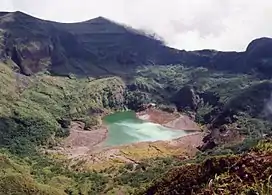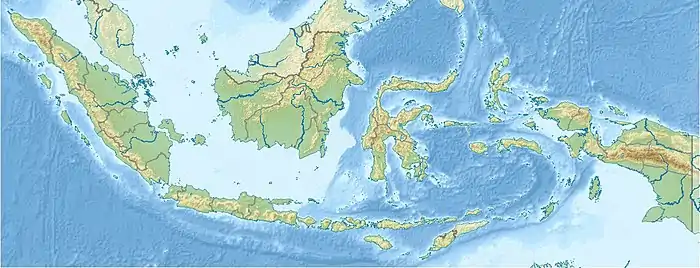Mount Awu
Mount Awu (Indonesian: Gunung Awu) is the largest volcano in the Sangihe chain, located on Sangir Island in North Sulawesi, Indonesia. Powerful eruptions occurred in 1711, 1812, 1856, 1822, 1892, and 1966 with devastating pyroclastic flows and lahars that have resulted in 11,048 fatalities.[2] A total of 18 eruptions are recorded from 1640, with two of VEI 4 (1814 and 1966) and 3 with VEI 3 (1711, 1856 and 1892), one eruption every ~ 20 years.[2] The hazardous nature of the volcano is determined from the continuous lava source driven by the geodynamic setting (a double subduction line that creates an arc–arc collision) and the presence of a crater lake, sustained by the consistent rainfall on the island, on top of a lava dome.[2] This setting creates the conditions for water injection in the lava dome, which can cause a water-magma explosion.[2]
| Mount Awu | |
|---|---|
 A shallow lake partially fills the summit crater in 1995 | |
| Highest point | |
| Elevation | 1,320 m (4,330 ft)[1] |
| Prominence | 1,320 m (4,330 ft) |
| Listing | Ribu |
| Coordinates | 3°40′N 125°30′E[1] |
| Geography | |
 Mount Awu Sangir Island, Sangihe Islands, Indonesia | |
| Geology | |
| Age of rock | 100,000 |
| Mountain type | Stratovolcano |
| Last eruption | June to August 2004[1] |
A 4.5 km wide crater is found at the summit and a deep valley forms a passageway for lahars, splitting the flanks from the crater. This is a volcano in the Ring of Fire.[1]
See also
References
- "Awu". Global Volcanism Program. Smithsonian Institution. Retrieved 2006-12-31.
- Bani, Philipson; Kristianto; Kunrat, Syegi; Syahbana, Devy Kamil (2020-08-07). "Insights into the recurrent energetic eruptions that drive Awu, among the deadliest volcanoes on Earth". Natural Hazards and Earth System Sciences. 20 (8): 2119–2132. Bibcode:2020NHESS..20.2119B. doi:10.5194/nhess-20-2119-2020. ISSN 1561-8633.